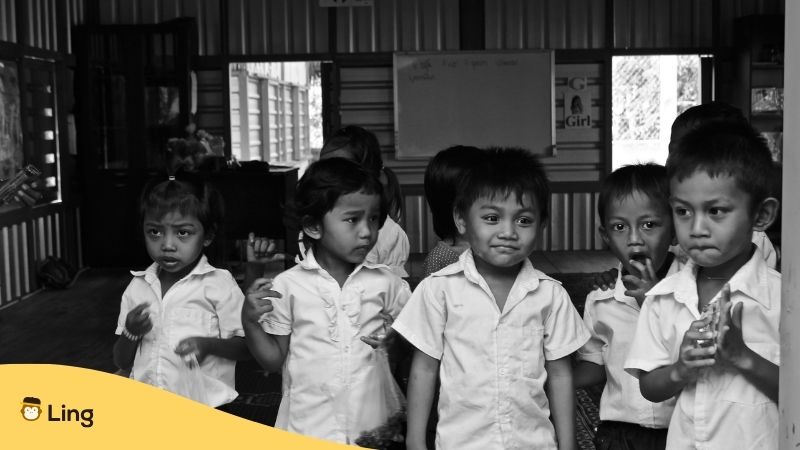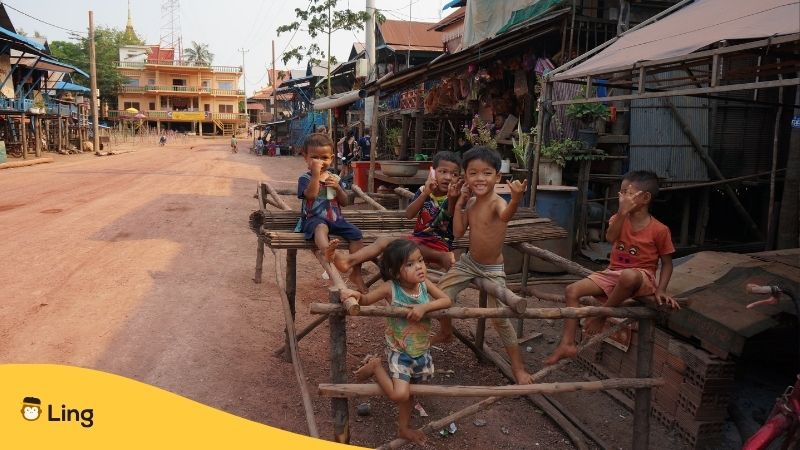Childhood is a time filled with laughter, imagination, and the thrill of discovery. In the same vein, Khmer childhood games have been cherished for generations, offering a unique blend of entertainment, physical activity, and cultural significance across Cambodia.
This time, we’ll take a journey through the streets and playgrounds of Cambodia, from Siem Reap to Phnom Penh, to explore the playful world of Khmer childhood games, learning about their origins, rules, and enduring popularity.
The Significance Of Khmer Childhood Games
In an age where digital devices dominate playtime, games offer an important opportunity for physical exercise. Running, jumping, and other physical activities promote a healthy lifestyle and teach children the value of staying active.
Often played in groups, Cambodian kid’s games are excellent for encouraging teamwork, cooperation, and the development of social skills. Children learn to communicate, strategize, and resolve conflicts while having fun.
Here are just a few:
1. Chab Kon Kleng (ចាប់កូនខ្លែង)
Objective: To protect as many “chicks” from the “crow”.
Rules: The strongest person in a group gets to imitate a mother hen protecting her chicks from a second player who is assigned the role of a hungry crow. The players imitating the chicks have to hide behind the hen while the crow tries to catch them.
Significance: Very popular with both children and adults at Khmer New Year.

2. Hitting The Clay Pot – Veay Ka’am (វាយឆ្នាំងដី)
Objective: To break a clay pot hanging from a string while blindfolded.
Rules: A clay pot is filled with small prizes and suspended from a tree branch or beam. The player is blindfolded and handed a wooden stick. They must strike the pot to break it and claim the treasures within.
Significance: Chab Kon Kleng is often played during Cambodian New Year celebrations symbolizing the breaking of old troubles and the welcoming of new beginnings. A bit like a clay Piñata.
3. Throwing Brown Nuts – Bos Angkunh (បោះអង្គុញ)
Objective: To hit the opponent’s angkunhs (a type of dried fruit/nut) on the ground by throwing your angkhuns at them.
Rules: Two groups of boys and girls take turns putting their angkunhs on the ground before the opposing group throws their angkunhs at them. The winners get to hit the losers on the knees with their dried fruit. If the noise of the fruit hitting the knees doesn’t make the correct tone, the loser gets to have a go at tapping their opponent’s knees with their nut.
Significance: Particularly popular at Khmer New Year. Great for hand-eye coordination and getting everyone together to throw nuts.
4. Tug Of War – Teagn Prot (ទាញខ្សែពួរ)
Objective: To pull the opposing team across a designated line.
Rules: Two teams hold onto opposite ends of a long rope and try to pull the other team across a line or marker. The team that successfully moves the opposition wins.
Significance: Teagn Prot is a test of strength and teamwork. It’s a popular game played at school events and festivals and is also played on the first night of the Khmer New Year between groups of girls and boys.
5. Bay Khom – បាយខុម
Objective: To be the player with the most seeds at the end of the game.
Rules: Played by two people with 42 seeds, beads, or stones. Ten holes are made in the ground and five seeds are placed into the two holes at each end. Four seeds are then placed into each of the remaining eight holes. Player number one takes all the seeds out of one of the holes and places them one by one into the other holes.
The process is repeated until the last seed has been placed into a hole next to an empty hole. All the seeds in the hole after the empty hole are then removed and player two takes over. When all the holes are empty of seeds, the game is over. The player with the most seeds is declared victorious. It is much easier to understand than it sounds after a couple of games.
Significance: Great for teaching kids strategy. Can be played by friends in both urban and rural areas.

6. Leak Kanseng (លាក់កន្សែង)
Objective: To catch the person who puts the Kanseng on the ground behind a person sitting on the ground.
Rules: All players sit on the floor in a circle facing each other while the one holding the Kanseng walks around the outside of the circle as the group sings: “Hide the Kanseng, the cat bites the heel and pulls the leg” (Leak Kanseng! Chhma khaaim keng! Oh long oh long). The Kanseng is then placed on the ground behind another of the children sitting in the circle. If the chosen child realizes, they must leap into action and chase the other player and try to catch them before they get back to their position in the circle.
Significance: A popular game where a whole group of kids gather with some time to kill. Teaches coordination, alertness, and agility.
7. Throwing The Scarf – Choal Chhoung (ចោលឈូង)
Objective: To throw and catch a scarf.
Rules: Two teams of boys and girls stand at a distance and throw a scarf back and forth to each other. The goal is to catch the scarf without dropping it. It is usual that one of the girls will try and hit one of the boys team she has a crush on.
Significance: Chol Chhoung is a game that strengthens hand-eye coordination and reflexes. It’s a charming and simple game that can be enjoyed by children of all ages and is a fun way for members of the opposite sex to get to know each other.
In an era where modern technology often takes center stage, it’s heartening to see these traditional games continuing to thrive and connect Cambodian youth with their heritage.
Learn More Khmer Culture With Ling
As well as learning everything you need to know about reading, writing, and speaking the Khmer language, the Ling has tons of blogs available about all aspects of culture and life in Cambodia for free. The Ling app is available now at Google Play and App Store.


































































